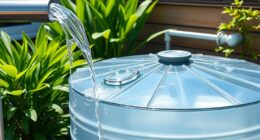A home eco-audit is a practical way to identify hidden energy wasters that may be increasing your utility bills and reducing comfort. By systematically inspecting your house, you can uncover drafts, leaks, and inefficient systems that often go unnoticed. Taking these steps not only saves money but also helps create a more sustainable living environment. Ready to start uncovering those energy drains and making your home more efficient?
Conducting a Visual Inspection of Your Home
To begin your home eco-audit, you should start with a thorough visual inspection. Walk through each room and outside your house, noting any obvious issues.
Look for cracks, gaps, or damaged seals around windows and doors that could let in drafts or cause heat loss. Check for signs of moisture, mold, or water damage, which can affect insulation effectiveness and indoor air quality. Examine your walls, ceilings, and floors for stains or deterioration.
Inside, look at your appliances, lighting fixtures, and HVAC system, noting their age and condition. Vetted electric bike conversion kits like the PEXMOR or AW models can serve as inspiration for assessing how well your existing systems are functioning and whether upgrades might improve efficiency.
Outside, inspect the roof, gutters, and siding for damage or debris.
This initial visual check helps you identify the most apparent energy wasters and prioritize areas needing further investigation or repair.
Checking for Air Leaks and Insulation Gaps
Have you ever felt a cold draft sneaking in around your windows or doors? That’s a clear sign of air leaks. To check, hold a lit candle or incense stick near seams, outlets, and window frames—if the flame flickers or smoke wavers, you’ve found a leak.
You can also use essential oils with decongestant properties, like eucalyptus or peppermint, to help detect drafts by their soothing aroma, which can indicate air movement. Don’t forget to inspect your attic and basement for insulation gaps. Gaps or thin spots let warm air escape and cold air enter, raising your energy bills. Use your hand to feel for drafts or use a thermal leak detector for a more precise assessment.
Sealing leaks with weatherstripping, caulk, or foam insulation is simple and effective. Addressing these issues improves comfort and cuts energy waste, saving you money in the long run.
Evaluating Your Heating and Cooling Systems
Regularly evaluating your heating and cooling systems ensures they operate efficiently and keep your home comfortable. Start by checking your thermostat settings—set them to optimal temperatures when you’re home and lower or raise them when you’re away or sleeping. Inspect your system for any strange noises or uneven heating and cooling, which can indicate issues. Replace filters regularly, as dirty filters reduce efficiency and increase energy use. Consider scheduling professional maintenance annually to ensure components like the furnace, air conditioner, and ducts are working properly. Use a smart thermostat to monitor and optimize energy use remotely. Finally, evaluate whether your system is the right size for your home; an oversized or undersized unit wastes energy and costs you more. Additionally, recent AI discoveries suggest that integrating AI-powered diagnostics could further enhance system efficiency by predicting potential failures before they happen.
Assessing Appliance Efficiency and Usage
Are your household appliances working as efficiently as they could be? Start by checking their age and condition. Older appliances often use more energy, so consider replacing outdated models with ENERGY STAR-rated ones. Monitor how often you use each appliance; running them only when needed reduces waste.
Pay attention to your refrigerator’s temperature—ideally between 37-40°F—and avoid overstuffing it, which hampers efficiency. For laundry, use cold water settings and full loads to save energy and water.
Unplug devices when not in use to prevent phantom energy drain. Regular maintenance, like cleaning filters and coils, keeps appliances running smoothly and efficiently. Additionally, appliance efficiency can be improved by upgrading to newer models with better energy-saving features.
Monitoring Lighting and Electronics Consumption
Monitoring your lighting and electronics consumption is essential for identifying areas where energy is wasted. Start by tracking when and where you use lights and devices. Use smart meters or energy monitors to get real-time data on their power usage. Regularly monitoring indoor air quality can also help identify hidden sources of pollution that may increase the need for air purification. Turn off devices when not in use, especially chargers, TVs, and computers. Consider replacing old bulbs with energy-efficient LEDs, which consume less power and last longer. Keep an eye on standby power; many electronics draw energy even when turned off. Setting timers or using smart plugs can help automate this process. Regularly reviewing your usage patterns highlights opportunities to cut back. Small adjustments, like dimming lights or unplugging unused electronics, can significantly reduce your household’s energy consumption and save you money.
Inspecting Windows and Doors for Drafts
Inspecting your windows and doors for drafts is a crucial step in reducing energy loss. Start by feeling around the edges for any cold air or noticeable drafts. A well-sealed rustic decor can significantly improve your home’s energy efficiency. On a windy day, hold a lit candle or incense stick near window and door frames; if the flame flickers or smoke moves, you’ve found a leak. Check for gaps, cracks, or worn weatherstripping that might let air in. Make sure hinges, locks, and seals are secure and intact. Use a flashlight to inspect for cracks or damage in frames and sills. If you find drafts, seal gaps with weatherstripping, caulk, or door sweeps. Taking these simple steps keeps your home warmer and lowers your heating bills.
Reviewing Water Heating and Plumbing Efficiency
After sealing drafts around windows and doors, it’s a good time to turn your attention to your home’s water heating and plumbing systems.
Start by checking your water heater’s temperature setting—ideally, it should be around 120°F to prevent overheating and save energy. Insulate your water heater and accessible pipes to reduce heat loss.
Look for leaks in faucets, toilets, and pipes, as these waste water and increase energy use. Consider installing aerators on faucets to reduce flow without sacrificing performance.
If your water heater is old, evaluate whether replacing it with an energy-efficient model could lower costs long-term. Regular maintenance and mindful usage can significantly improve efficiency, cut energy bills, and extend the lifespan of your plumbing system.
Monitoring your energy consumption and understanding how to optimize your system can further enhance efficiency and reduce costs over time.
Using Tools to Detect Hidden Energy Losses
Using tools to detect hidden energy losses allows you to identify issues that aren’t visible to the naked eye, saving you money and improving your home’s efficiency.
Infrared thermometers can reveal drafts and insulation gaps by showing temperature differences on walls and ceilings.
A blower door test measures how much air leaks from your home, pinpointing problem areas.
Using a thermal camera helps visualize heat escaping through windows, doors, or walls, making it easier to target repairs.
Plug load meters track energy use from individual devices, identifying electronics that waste power even when off.
Combining these tools gives you a clear picture of where energy is being lost, so you can prioritize fixes that maximize savings and comfort.
Understanding insulation’s role in energy efficiency can guide you in making more effective improvements.
With the right equipment, uncovering hidden inefficiencies becomes straightforward and effective.
Developing a Plan to Address and Improve Energy Efficiency
Once you’ve identified where energy losses occur, the next step is to create a focused plan of action. Start by prioritizing the most significant issues that impact your energy bills and comfort. Incorporate energy-efficient practices, such as using LED lighting and optimizing thermostat settings, to maximize savings. Set clear, achievable goals, like sealing leaks, upgrading insulation, or replacing inefficient appliances. Break these goals into manageable tasks with deadlines to stay on track. Consider the costs and benefits of each improvement, and look for ways to save money, such as rebates or discounts. Keep a record of your progress and reassess periodically to ensure your efforts are effective.
Conclusion
By thoroughly inspecting your home and addressing hidden energy wasters, you can boost efficiency, lower bills, and create a more comfortable space. Regular audits help catch issues early and keep your home eco-friendly. Take action now—seal leaks, upgrade insulation, and optimize your systems. Small improvements make a big difference over time. Keep monitoring and maintaining your home to enjoy ongoing savings and a healthier environment for you and your family.



